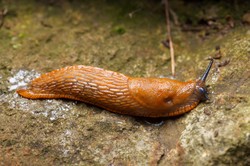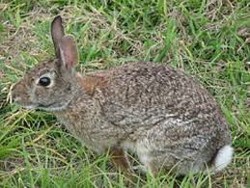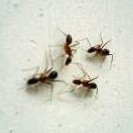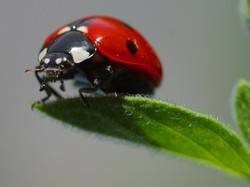Integrated pest management is a technique in which gardeners and farmers use a co-ordinated system of tactics and tools to overcome pest threats. Along with the techniques outlined above there are cultural techniques, what the gardener does with his/her tools and time.
One technique is to lay a tarpaulin or carpet overnight. The slugs will gather under this and in the morning lift it to pick them up. This tactic works best when you can throw them to the ducks or otherwise dispose of them, maybe by chopping them in half. Their bodies can be left on the compost heap or left out for birds.
Prevention is better than cure, and so it is considered good practice to maintain the garden so that debris and detritus is not left lying around, for slugs like to hide underneath it. You cannot eliminate all places in which slugs can hide, but you can minimize them.
When digging if you uncover small white eggs collect them and either drop them in water or place them on the bird table, where they will play their part in the cycle of nature, feeding avian predators.
There is discussion about gritty materials and their ability to deter slugs. I have applied some potash from the woodfire and have had no slugs on the area, though I also have wool pellets as well, so it is hard to say. Some gardeners strew crushed egg shells around the plants to be protected, but this has not always been considered effective and rats like licking the insides of shells that contains egg residue.
Copper strips at the entrances to garden buildings are said to deter slugs, as their slime reacts with the copper to produce a slight electrical current, which gives them a shock. However, I tried this technique in the kitchen of my previous house, but it did not work well.
Pouring salt upon slugs kills them quickly, but in large quantities it does not do your garden any good and it is better used on patios.
Sadly slugs and gardeners are enemies, and if left alone the slugs will strip your food crops bare, and the implication of this is that if we want to have food we have to suppress slugs. Even the most dedicated vegetarian gardeners need to deal with the slug problem. Dealing with pests is not the nicest side of gardening, but it is a necessary process.










 TheThousand Year Gardenon 11/26/2025
TheThousand Year Gardenon 11/26/2025
 Women of the Gospelson 10/11/2025
Women of the Gospelson 10/11/2025
 Religious Gardenson 08/25/2025
Religious Gardenson 08/25/2025
 Doctor of the Church: John Henry Newmanon 08/03/2025
Doctor of the Church: John Henry Newmanon 08/03/2025




Comments
No problems. They have their role in the ecosystem
Thank you!
Dorling Kindersley made Fungi: Discover the science and secrets behind the world of mushrooms by Lynne Boddy and Ali Ashby this year.
How might you feel about fungi in your mulch?
All mulch attracts slugs and snails. One type of mulch does notnattract more than another.
The introductory paragraph cautions us about slugs clustering under winter mulch.
Is all mulch attractive to slugs or might there be some mulches -- such as leaf mold -- more attractive than others?
It is a standard beer glass, nothing special about it.
Thank you for your comment April 6, 2023, in answer to my previous question April 5, 2023.
English Wikipedia carries the article Boddingtons Bitter. It displays that beer in a glass alongside a can.
That glass looks distinctive, with a bulge perhaps one-third down from the rim, two-thirds up from the bottom.
Might that glass be specific to Boddingtons bitter or might it just be a bar-style glass for any drink?
Boddington's is best.
The closing sentences in the last paragraph to your first subheading, Types of Slug, amused me in what it called up of imagined tipsy slugs.
What would be name-brand examples of "quality bitter" beers on your, eastern-pond side?
Raking leaves in woodlands is counter-productive, as their decay is part of the cycle of nutrients. I would be interested in reading about your experiences of white deer.
I have slugs here in the US. I have the grey ones and the orange ones. Thanks for this article. I didn't know what their eggs look like and no I do and have a plan to rid them now. I go for the natural way. We live in the woods and there are leaves all over the place. This year though, I don't want my husband to rake them up. We have lots of white-tailed deer and they are coming to forage in the grass that is growing beneath the leaves. I shall have to write about my deer soon.